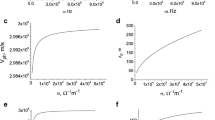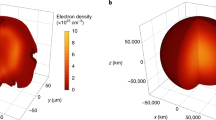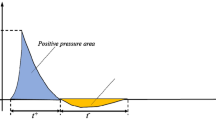Abstract
HESS1 declared as far back as the turn of the century that the luminosity at the detonation of a free charge depends on ‘pneumatic heating’ of the surrounding air. Some decades later Lafitte2 and Michel-Lévy and Muraour3 confirmed in extensive investigations that the light is mainly emitted by the surrounding air. When a cylindrical charge detonates in a tube the detonation gas acts as a piston with supersonic velocity. In front of this the gas atmosphere is collected in a compressed layer with a shock front4. Investigations by Bethe5, Fuchs, Kynch and Peierls6, Brinkley, Kirkwood and Richardson7, Hirschfelder and Magee8 and others are available for calculating the state of the layer. The compressing work is considerably greater than with a reversible adiabatic because the piston works from the very beginning against the terminal pressure. About half the work is consumed to provide the layer with kinetic energy and the remainder is converted into internal energy which gives the air a high temperature. If it is obstructed by an obstacle the kinetic energy is transformed into internal energy. For high explosives in air, the rise in temperature that is then obtained can be expected to increase the intensity of radiation by 103–104 times. This depends partly on the increase of blackbody radiation with temperature, but the main reason is that, according to Burkhardt9, the emission coefficient for air layers 1 cm in thickness varies very rapidly with the temperature below about 10,000° K.
This is a preview of subscription content, access via your institution
Access options
Subscribe to this journal
Receive 51 print issues and online access
$199.00 per year
only $3.90 per issue
Buy this article
- Purchase on Springer Link
- Instant access to full article PDF
Prices may be subject to local taxes which are calculated during checkout
Similar content being viewed by others
References
Hess, P., Mitteilungen Gegenstände Artillerie Geniewes, 31, 26 (1900).
Lafitte, P., Ann. de Phys., 4, 295 (1925).
Michel-Lévy, A., and Muraour, H., C.R. Acad. Sci., Paris, 198, 1760 (1934); 200, 924 (1935).
Johansson, C. H., Arkiv Matem. Astr. Fysik, Stockholm, 33, A, 1 (1946).
Bethe, H. A., OSRD 2307, PB 27, 307 (1942).
Fuchs, K., Kynch, G. J., and Peierls, R., Los Alamos Rep., 8 M-83 (1942).
Brinkley, S., Kirkwood, J., and Richardson, J., OSRD 3550, PB. 32194 (1944).
Hirschfelder, J. O., and Magee, J. L., Los Alamos, MDDC 590, PB. 63828 (1947).
Burkhardt, G., Conf. Lab. Rech. Techn., Saint-Louis, France, 309 (Oct., 1951).
Author information
Authors and Affiliations
Rights and permissions
About this article
Cite this article
JOHANSSON, C., SJÖLIN, T. Light Emission from Shock-front Compressed Air Layers in Tubes. Nature 200, 352–353 (1963). https://doi.org/10.1038/200352b0
Issue Date:
DOI: https://doi.org/10.1038/200352b0
Comments
By submitting a comment you agree to abide by our Terms and Community Guidelines. If you find something abusive or that does not comply with our terms or guidelines please flag it as inappropriate.



